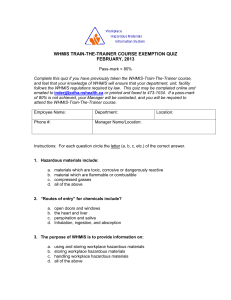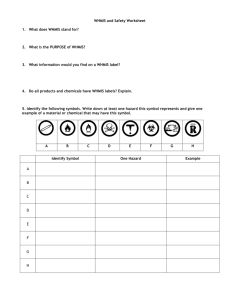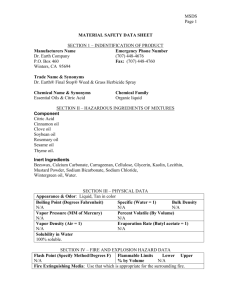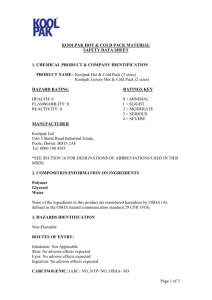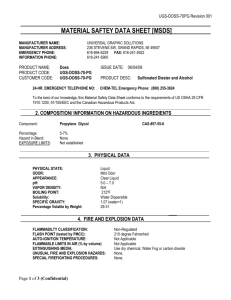WHMIS - Information
advertisement
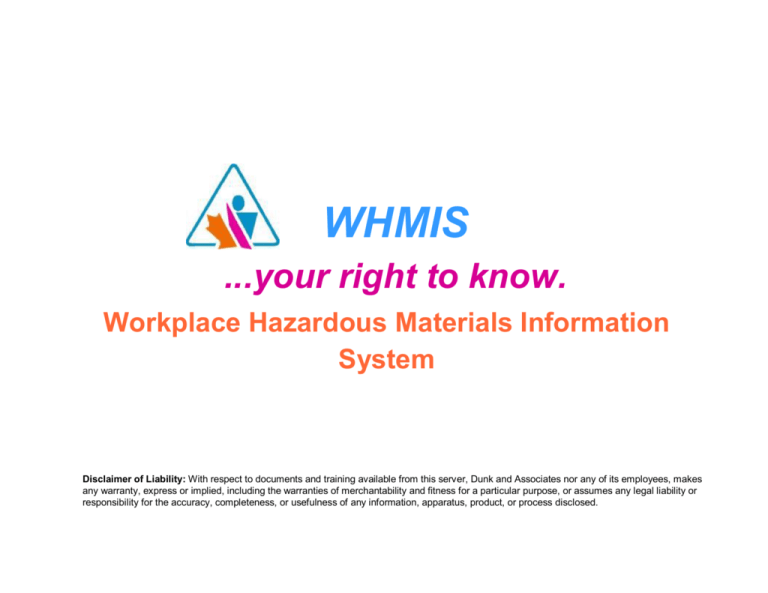
WHMIS ...your right to know. Workplace Hazardous Materials Information System Disclaimer of Liability: With respect to documents and training available from this server, Dunk and Associates nor any of its employees, makes any warranty, express or implied, including the warranties of merchantability and fitness for a particular purpose, or assumes any legal liability or responsibility for the accuracy, completeness, or usefulness of any information, apparatus, product, or process disclosed. WHMIS At Your Workplace It is important that All staff in the workplace develop the know­how to work safely and be ready to deal with accidents and emergencies should they occur. You don’t have to handle a controlled product to be put at risk. The hazards of dangerous chemicals can affect everybody, but becoming familiar with WHMIS will allow you to protect your health. Workplace Hazardous Materials Information System W.H.M.I.S. Ensures that ‘your right to know’ about hazardous materials in your workplace is given to you in three (3) ways: • Labels – Supplier and Workplace • Material Safety Data Sheet – (M.S.D.S.) •Training – Generic and Department Specific Responsibilities The following parties are responsible for compliance under WHMIS Legislation: µ The Government µ Suppliers/Manufacturers µ Employers µ Employees Government Federal legislation ensures that WHMIS is applied consistently across Canada Applies to Suppliers of hazardous materials Sets the framework for the Hazardous Products Act and “the Right to Know” regarding exposure to hazardous materials on the job. Provincial legislation provides the operating details that enable WHMIS to be enforced Suppliers and Manufacturers Must determine which products are controlled products under WHMIS and classify them accordingly Assign proper WHMIS hazard symbols to controlled products Provide information about hazardous products via a supplier label in both English and French Revise and update MSDS and labels as new information on a controlled product or substance becomes available or once every three years Employers µ Ensure that all containers of controlled products or substances coming into the workplace have a legible supplier label µ Must obtain the MSDS from suppliers and ensure current MSDS are readily accessible for workers to review (in both English and French) µ Establish education and training programs for workers who may be exposed to hazardous materials in the workplace µ Review information and training program annually to evaluate their effectiveness µ Provide PPE (personal protective equipment) for employees µ Update any MSDS with any new or updated information Workers µ Participate in WHMIS training programs µ To inform management about damaged or missing supplier labels µ Be aware of the location of MSDS and notify management of any invalid or missing MSDS µ Use PPE and handle controlled products in a safe manner W.H.M.I.S. Training Requirements As an employee you are responsible: • To participate in the initial core W.H.M.I.S. training (available at orientation) • To participate in the annual W.H.M.I.S. review • To participate in and review your Department Specific MSDS training •To participate in protection training regarding hazardous spills and chemical hazards WHMIS Classes and Their Symbols To help you protect yourself from the potential dangers of controlled products, WHMIS supplier labels will always display one or more standardized hazard symbols enclosed in a unique round border. To work responsibly, you need to become familiar with 6 classes or types of hazardous material, represented by eight symbols. (Class D is divided into 3 subclasses and has 3 distinct hazard symbols.) W.H.M.I.S. Hazard Symbols 6 Classes & 8 Symbols Class A Compressed Gas Class B Flammable & Combustible Class C Oxidizing Class D1 Poisonous Class D2 Toxic Class D3 Biohazardous/ Infectious Class E Corrosive Class F Dangerously Reactive CLASS A: COMPRESSED GAS This class includes compressed gases, dissolved gases, and gases liquefied by compression or refrigeration and may rupture or explode if container handled improperly by heat, being dropped, or exposed to incompatible substances. Preventative Measures: ensure container is always secured store in upright position, chained or restrained in a cool, dry ventilated area mark empty containers and store separately use in well ventilated areas CLASS B: FLAMMABLE AND COMBUSTIBLE MATERIAL This class includes solids, liquids, and gases capable of catching fire in the presence of a spark or open flame under normal working conditions. This class can also spontaneously burst into flames given the right circumstances. Preventative Measures: store in properly designated areas work in well ventilated areas avoid heating or other sources of heat, sparks, or flames properly ground and bond containers when dispensing these liquids CLASS C: OXIDIZING MATERIAL These materials increase the risk of fire if they come in contact with flammable or combustible materials. This includes any material that contributes to the burning of other material by producing oxygen or oxidizing substances. Oxidizers should be kept away from flammable materials Preventative Measures: store in areas away from combustibles avoid shock, heat, and friction CLASS D: POISONOUS AND INFECTIOUS MATERIAL Division 1: Materials Causing Immediate and Serious Toxic Effects These materials can cause death or immediate injury when a person is exposed to small amounts. Can be inhaled, ingested or absorbed via the skin Preventative Measures: avoid breathing dust, gas, or vapours avoid contact with skin and eyes wear proper personal protective equipment (PPE) work in well ventilated areas CLASS D: POISONOUS AND INFECTIOUS MATERIAL Division 2: Materials Causing Other Toxic Effects These materials can cause life­threatening and serious long­term health problems as well as less severe but immediate reactions in a person who is repeatedly exposed to small amounts. These products can be inhaled, swallowed or absorbed through skin (also known as routes of entry) and can cause allergies, respiratory irritation, birth defects or sterility. Preventative Measures: work in well ventilated areas wear required personal protective equipment keep container tightly closed wash thoroughly after use CLASS D: POISONOUS AND INFECTIOUS MATERIAL Division 3: Biohazardous Infectious Material These materials contain harmful micro­organisms that have been classified into Risk Groups 2, 3, and 4 as determined by the World Health Organization (WHO) or the Medical Research Council of Canada. Preventative Measures: handle material only when fully protected keep containers tightly closed handle in designated areas to prevent exposure CLASS E: CORROSIVE MATERIAL This class includes caustic and acid materials that can destroy the skin or eat through metals. Preventative Measures: avoid skin and eye contact wear required personal protective equipment work in well ventilated areas CLASS F: DANGEROUSLY REACTIVE MATERIAL These products may self­react dangerously (for example, they may explode) upon standing or when exposed to physical shock or to increased pressure or temperature, or they emit toxic gases when exposed to water. Preventative Measures: handle with care store in proper containers WHMIS LABELS One of the first identifiers of a WHMIS warning is in the form of a label. Labels are easily recognized and provide basic information related to the hazardous material. Therefore all containers of hazardous material must be properly labeled. The labels on containers of WHMIS controlled products are required to follow very precise guidelines that must be enforced by everyone in the workplace. WHMIS LABELS There are two (2) types of labels: Suppliers Labels ­ Workplace Labels All WHMIS labels must be: • • • • Visible under normal conditions of storage Easy to see Durable Attached so they remain easy to read W.H.M.I.S. Supplier LABELS Supplier Labels: • identified by broken border • contains 7 pieces of information • Displays one or more standardized hazard symbols enclosed in a unique round border Label Requirements: 1. 2. 3. 4. 5. 6. 7. Product Identifier Name of Supplier MSDS Reference Hazard Symbol Risk Phrases Precautionary Measures First Aid Measures W.H.M.I.S. Workplace LABELS Workplace Labels for use when: • supplier label is dirty or unreadable • supplier label is missing • controlled product is transferred from original container or decanted • if controlled product is employer produced PRODUCT IDENTIFIER: METHANOL INSTRUCTIONS: FLAMMABLE ­ DO NOT USE NEAR AN OPEN FLAME OR PROCESSES THAT GENERATE SPARKS. AVOID INHALING VAPOURS PROTECTIVE EQUIPMENT REQUIRED: USE ONLY WITH RESPIRATOR, GOGGLES, AND GLOVES REFERENCE MATERIAL: READ THE MATERIAL SAFETY DATA SHEET (MSDS) FOR FURTHER INFORMATION BEFORE USING THIS PRODUCT. Three types of Information must be included: 1. Product Identifier 2. Safe Handling Procedures 3. Statement that MSDS is available. SUPPLEMENTARY LABELS Many controlled products may be stored in pipelines, tanks etc. In these situations, the use of placards, colour coding or other means of identification is acceptable under WHMIS, (except those used for transport, which is covered in the Transportation of Dangerous Goods Act), provided that all workers are properly trained in the identification system This label is divided into 4 diamond shaped sections. Each section contains a number to indicate the degree of hazard and a colour to indicate the nature of the hazard. The higher numbers indicate a greater hazard. This label system is often used with a wall chart or poster. MATERIAL SAFETY DATA SHEETS (MSDS) Under WHMIS legislation suppliers and manufacturers are required to provide Material Safety Data Sheets (MSDS) for the controlled products they distribute. Employers are in turn required to obtain a MSDS on all the controlled products in their workplaces. Employees are required to review the MSDS before handling a hazardous chemical for the first time. W.H.M.I.S. Material Safety Data Sheet (M.S.D.S.) The MSDS is the back­up to the label and it must: •be updated every 3 years •be available to all employees at the site •be located in most departments •contain 9 pieces of information Required Information: 1. Product Information 2. Hazardous Ingredients 3. Physical Data 4. Fire and Explosion Data 5. Reactivity Data 6. Toxicological Properties 7. Preventative Measures 8. First Aid Measures 9. Preparation Data Remember: Department specific review of MSDS is required with each employee. Please review your department’s MSDS. W.H.M.I.S. Material Safety Data Sheet (M.S.D.S.) The MSDS must be readily available and kept in a convenient location for examination by employees and the Health and Safety Committee. Knowing where the MSDS’s are kept in your workplace and learning how to use this valuable resource is part of your job The MSDS contains information that will be important in handling emergencies or spills, or in designing controls for the safe use of the material without worker exposure. MSDS CONTENTS EXPLAINED 1. Product Information Identifies the product with the same name displayed on the label, chemical name and any other names by which the product is known. Also shows the address and emergency phone numbers for the manufacturer and supplier and contact information about where to get additional information about the chemical. Gives an explanation of the product application. Note: Depending on the supplier/manufacturer, sections may appear on a MSDS in different order. MSDS CONTENTS EXPLAINED 2. Hazardous Ingredients Lists all ingredients of the product, which come under any of the six hazard classes. The concentration of each ingredient is also listed. Gives the Chemical Abstracts Service (CAS) number for each hazardous ingredient in the event that you need additional information. MSDS CONTENTS EXPLAINED 3. Physical Data Explains how the material behaves when in use. Includes descriptions of physical state, odour and appearance, specific gravity, freezing and boiling points, vapour pressure and evaporation rate. 4. Fire and Explosion Data Describes the likelihood of the material burning or exploding under different circumstances such as; exposure to various temperatures, exposure to static electricity, sharp impact, etc. Also includes information on extinguishing fires involving the product. MSDS CONTENTS EXPLAINED 5. Reactivity Data Describes the stability and compatibility of the material. How it behaves when exposed to other chemicals, heat, light, vibration, air or moisture, etc. 6. Toxicological Properties Description of the route of entry to the body, effects of the chemical on the body, organs, tissues and the person overall, and acute and long term (chronic) symptoms associated with exposure. MSDS CONTENTS EXPLAINED 7. Preventative Measures Recommends safe procedures for handling, use and storage of the material, based on all the hazard data given in other sections. Also includes data on personal protective equipment, waste disposal and procedures to be followed in case of a leak or spill. 8. First Aid Measures Describes the immediate treatment to be given to a person who has been affected by acute exposure to the material. MSDS CONTENTS EXPLAINED 9. Preparation Data Gives the name and phone number of the person or department who prepared the data sheet, as well as the date on which it was issued. Must be revised every three years or 90 days of new hazard information. Additional Information This space may contain any information the supplier or manufacturer feels might be relevant to the use. Additional toxicological or other scientific information may be included. HAZARDOUS SUBSTANCES NOT CONTROLLED BY WHMIS The following substances have been excluded from the WHMIS requirements under their own respective legislation, however the employer is required to train employees regarding the hazards with these substances and the precautions to be taken. • Explosives (under Explosives Act) • Cosmetics, devices, drugs or food (under Food and Drug Act) • Pest control Products ­ insecticides, herbicides, fungicides, rodenticides (under Pest Control Act) • Prescribes Products (under Atomic Energy Control Act) • Consumer Products (under the Hazardous Products Act) • Hazardous Waste • Wood and products made of wood • Tobacco and tobacco products • Manufactured Articles COPING WITH EMERGENCIES Fire, explosion and unsafe exposure to harmful chemicals can happen in any workplace where hazardous products are used. WHMIS legislation does not require you to become an expert in coping with every potential hazard, but it does expect you to become familiar with your site’s emergency resources and procedures. ON­SITE RESOURCES Having the correct information will help you deal with a potentially dangerous situation effectively. The following chart will remind you where to look. HAZARD EMERGENCY INFORMATION SOURCE Spill/Leak MSDS Fire/Explosion MSDS Improper Exposure Supplier labels/Consumer labels/ MSDS Fugitive Emissions MSDS REPORTING ACCIDENTS AND INJURIES Occupational Health and Safety legislation states that injuries and certain categories of accidents must be reported to prevent similar occurrences in the future. In the event of an emergency, it is your job to alert your supervisor or Health and Safety representative as promptly as possible so appropriate action can be taken. To this end, most workplaces have an established set of policies on how to deal with emergencies. Please check with your supervisor to review the individual policy. Health Hazards Some hazardous materials may present a physical safety hazard and result in fire, explosion or corrosion. These hazardous materials may also directly, or indirectly, cause injury or death in humans. HEALTH HAZARDS Hazardous materials in the workplace can be classified into 3 main categories; 1. Biological (i.e. Bacteria, viruses) 2. Chemical (i.e. Solid, liquid, gas) 3. Physical (i.e. Heat, noise, radiation, vibration) There are several factors that influence whether a hazardous material will impair your health. sHow toxic is the hazardous material sThe amount of hazardous materials entering the body sThe routes of exposure sHow quickly the hazardous material is absorbed into the bloodstream sWhere the hazardous material goes in the body sThe routes of exit (how well the body deals with the hazardous material) HEALTH HAZARDS There are two types of health hazard effects: ACUTE and CHRONIC. Acute ­ Are health effects that occur quickly and can harm the body after one single exposure Chronic ­ Will develop over time ­ Occur after repeated small exposures ­ May show up, years, after a single large exposure ­ Carcinogen – can cause cancer after repeated exposure ­ Sensitizer – causes allergic reaction that worsens with each exposure ROUTES OF ENTRY Absorption • Entry through skin, or mucous membranes • Includes splashes, mists, spills, and vapours – may cause burns • May be absorbed and affect another part of the body Ingestion • Caused by eating, drinking or smoking with contaminated hands or in contaminated areas • Caused by eating or drinking from contaminated containers Injection • Punctures from sharp objects • Broken glass • Open wound • Pressurized vessel leaks HAZARDOUS WASTE Hazardous waste may be defined as any regulated product containing potentially dangerous substances that is intended for disposal or is sold for recycling or recovery. HAZARDOUS WASTE Although WHMIS does not require employers to provide workplace or supplier labels for hazardous waste, all containers must be clearly identified to alert employees that a potential danger exists. The following precautions will help you prevent the hazardous wastes in your workplace from becoming a potential danger: a always consult the product’s MSDS or label for information on safe disposal a keep waste disposal containers clean and in good repair a use required personal protective equipment when handling hazardous waste a never mix different chemical wastes Summary Handle and use all controlled products SAFELY in accordance with the Material Safety Data Sheet The WHMIS training is now complete. Please proceed for testing.

